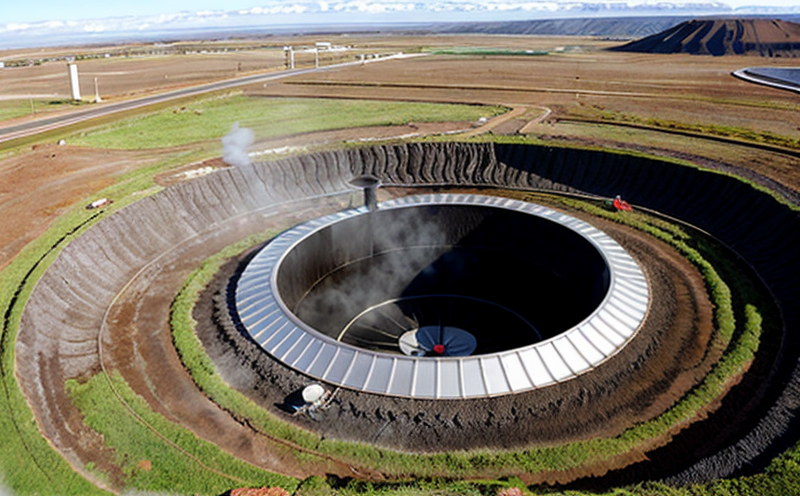ASTM E709 Magnetic Particle Testing of Geothermal Turbine Parts
The ASTM E709 standard provides a comprehensive framework for magnetic particle testing (MT) in the context of ferromagnetic materials. This testing method is particularly valuable within the energy sector, especially when evaluating the integrity and condition of critical components such as turbine parts used in geothermal power generation systems.
Geothermal energy harnesses heat from the Earth to generate electricity, relying heavily on robust and reliable equipment. Turbine parts are among the most crucial elements ensuring efficient operation. These components operate under extreme conditions, including high temperatures, corrosive environments, and mechanical stress. As such, ensuring their structural integrity is paramount for safety and performance. Magnetic particle testing serves this purpose by detecting surface and near-surface flaws that could compromise these critical parts.
The process involves applying a magnetic field to the component and introducing a magnetic flux. When there are defects within the part, the magnetic flux lines encounter irregularities and form leakage fields around them. These leakage fields attract ferromagnetic particles suspended in an appropriate carrier medium, allowing inspectors to visualize and assess the defects.
ASTM E709 specifies detailed procedures for MT, including the selection of suitable magnetization techniques, application methods, and evaluation criteria. Compliance with this standard ensures consistent and reliable results across different testing facilities, enhancing trust and consistency in quality assessment.
The accuracy and reliability of magnetic particle testing are further enhanced by adhering to ASTM E709 guidelines. These include:
- Proper selection of magnetization methods
- Application techniques for the carrier medium
- Evaluation of test results based on established criteria
- Use of appropriate equipment and materials
The testing process is critical for maintaining the longevity and safety of geothermal turbines. By identifying potential flaws early, it prevents catastrophic failures that could lead to costly downtime or even accidents.
| Industry Applications | Description |
|---|---|
| Geothermal Energy Systems | Turbine parts and other ferromagnetic components in geothermal systems are subject to high stress and corrosive environments. Magnetic particle testing ensures their integrity. |
| Power Generation Facilities | Testing critical components helps ensure the reliability of power generation processes, reducing risk and maintenance costs. |
| Maintenance and Repair Services | Avoiding failures in complex machinery through regular testing ensures that repairs are targeted only where necessary, conserving resources and time. |
In summary, ASTM E709 magnetic particle testing is a vital tool for the energy sector, particularly in geothermal systems. It plays a crucial role in ensuring the structural integrity of critical components, thereby enhancing safety and operational efficiency.
Benefits
The implementation of ASTM E709 magnetic particle testing offers numerous benefits to various stakeholders within the energy sector:
- Safety Enhancement: Identifying flaws before they lead to catastrophic failures enhances overall safety.
- Increased Reliability: By ensuring that critical components are free from defects, reliability is significantly improved.
- Cost Reduction: Preventing costly repairs and replacements due to unforeseen failures can be substantial.
- Compliance: Adherence to international standards like ASTM E709 ensures compliance with regulatory requirements.
- Data Accuracy: Consistent testing methods lead to accurate data, which is crucial for informed decision-making.
- Risk Management: Early detection of flaws allows for proactive risk management strategies.
The benefits extend beyond the immediate context of geothermal systems to encompass broader energy infrastructure and maintenance practices. By integrating ASTM E709 into their processes, organizations can achieve a safer, more efficient, and cost-effective operation.
Industry Applications
| Application Area | Description |
|---|---|
| Geothermal Turbine Parts | Detection of surface and near-surface flaws in critical components to ensure safe and reliable operation. |
| Turbine Blades | Evaluation of metal fatigue and corrosion resistance in high-stress areas. |
| Shafts and Bearings | Identification of cracks or other defects that could lead to failure under load. |
| Metal Fasteners | Assessment of integrity in fasteners critical for structural stability. |
| Cooling Systems | Detection of leaks and other defects that can compromise system efficiency. |
| Power Transmission Equipment | Ensuring the reliability and safety of equipment used in power generation processes. |
The versatility of ASTM E709 MT allows it to be applied across various components within geothermal systems, enhancing overall system integrity and performance. This comprehensive approach not only ensures the longevity of each component but also contributes to the sustainability and reliability of energy production.
Use Cases and Application Examples
The use of ASTM E709 magnetic particle testing in geothermal systems involves several practical applications:
- New Component Inspections: Ensuring that newly manufactured turbine parts meet the required standards before installation.
- Preventive Maintenance: Regular inspections to identify and address potential issues early, preventing failures during operation.
- Reconditioning: Evaluating components for reconditioning to ensure they are safe for continued use.
- Damage Assessment: Post-incident evaluation of damaged parts to determine the extent of damage and inform repair strategies.
- New Technology Validation: Testing new materials or designs to ensure they meet specified standards before full-scale implementation.
- Compliance Audits: Conducting tests as part of regulatory compliance audits, ensuring adherence to international standards.
These use cases demonstrate the versatility and importance of ASTM E709 in maintaining high standards within geothermal systems. By adhering to these practices, organizations can ensure that their equipment operates efficiently and safely, contributing to overall energy production sustainability.





